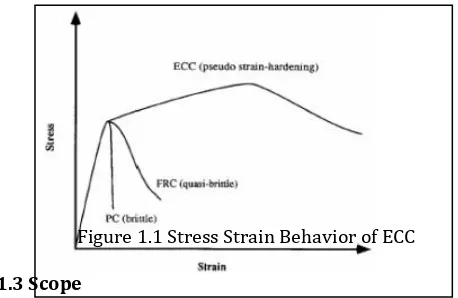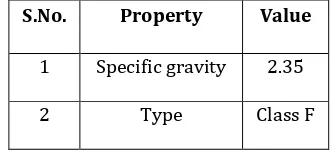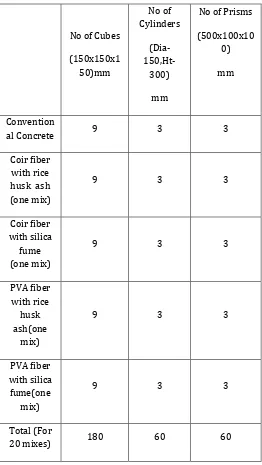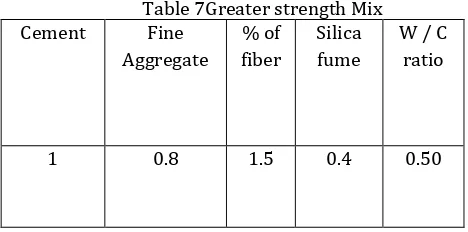© 2017, IRJET | Impact Factor value: 5.181 | ISO 9001:2008 Certified Journal | Page 629
EFFECT OF COIR FIBER AND POLYVINYL ALCOHOL FIBER ON
DURABILITY PROPERTIES OF ENGINEERED CEMENTITIOUS
COMPOSITES
R.Sathishkumar
1, S.Ranjith
21
post graduate,Dept. of civil engineering,EBET Group of Institutions,Kangayam,Tamilnadu,India
2Assistant Professor, Dept. of civil engineering,EBET Group of Institutions,Kangayam,Tamilnadu,India
---***---Abstract
- Traditional concrete is considered as brittle andrigid, also conventional concrete is not highly durable. The lack of durability of concrete is on account of the presence of calcium hydroxide and the transition zone, which represents the interfacial region between the particles of coarse aggregate and the hardened cement paste. Coir bars are used in concrete members to keep cracks as small as possible. But they are not small enough to heal, so water and deicing salts can penetrate to the coir, causing corrosion that further weakens the structure by affecting the durability. This result is development of engineered cementitious composites. The purpose of this project is to study the Durability properties of Engineered Cementitious Composites. To verify that, in this project Coir fiber and polyvinyl alcohol fiber with various proportions of mineral admixtures such as rice husk ash and silica fume has been used in ECC to study its structural performance and durable properties.
Key Words: engineered cementitious composites, Durability
properties, Coir fiber and polyvinyl alcohol fiber, rice husk ash and silica fume
1.INTRODUCTION
Concrete is the most preferred and the single largest building material used by the construction industry. Concrete is basically made of aggregates, both fine and coarse, glued by a cement paste which is made of cement and water. There might be the usage of admixtures in special cases. Concrete can be molded into any shape and size. Conventional concrete is brittle and rigid in nature. It has high compressive strength, low tensile strength, ductility and it is not highly durable. This above property of concrete might lead to some problems if it is practiced in construction sites. The search for an alternative, in order to overcome above problems lead to the formation of Engineered Cementitious Composites (ECC) which is a breed of high-performance fiber reinforced cementitious composites featuring significant tensile strength and ductility. Engineered Cementitious Composites also contributes to high durability. Thus ECC Contribute to safer, more durable and sustainable concrete infra-structure that is cost effective and constructed with conventional concrete equipment. In
this project, in order to study the durability properties of ECC, the transition zone which exists between the cement paste and coarse aggregate was removed by replacing the coarse aggregates completely with Coir fibers and PVA fibers and their structural performances were studied separately
1.2 Engineered Cementitious Composites
ECC is ductile in nature. ECC was prepared in ready mix plant and transported to construction sites and can be placed without the need for vibration due to its self-consolidating characteristics. ECC is a special type of high performance fiber reinforced cementitious composites that can be designed effectively with the guidance of micromechanics models. ECC has high strain capacity of about 3 to 5% compared to 0.01% for normal concrete. The large strain capacity of ECC is contributed by sequential development of multiple cracks, instead of continuous increase of crack opening. The damage tolerance and controlled crack width of ECC improve the serviceability and durability performance of Infrastructures. ECC has variety of unique properties, including tensile properties superior to other fiber reinforced composites.
pseudo-strain-© 2017, IRJET | Impact Factor value: 5.181 | ISO 9001:2008 Certified Journal | Page 630 hardening properties based on micromechanical principles
[image:2.595.38.267.209.358.2]has been referred as Engineered Cementitious Composites. In the first generation of these composites have been used only cement and silica fume in their matrix, with no aggregates. ECC can use a matrix incorporating suitable aggregates that will result in higher Elastic modulus. The Stress-Strain Behavior of ECC was shown in Figure 1.1
Figure 1.1 Stress Strain Behavior of ECC
1.3 Scope
ECC more flexible than traditional concrete acts more like metal than glass. Traditional concrete being brittle and rigid, suffers failure when strained in earthquake or by routine overuse and hence it should be studded with specially-coated reinforcing fibers to hold it together. ECC remain intact and safe to use at tensile strains up to 5%. The usage of coir bars in RCC is to keep cracks as small as possible. But they are not small enough to heal, so water and deicing salts can penetrate to coir, causing corrosion that further weakens the structure, The self-healing ECC concrete needs no coir reinforcement to keep crack width tight, so it eliminates corrosion. ECC has been successfully applied to dam repair, bridge deck overlays,
coupling beams in high rise buildings and other structural elements and systems. The properties of ECC (high damage tolerance, high energy absorption, and ability to deform under shear) give it superior properties in seismic resistance applications when compared to normal concrete. Apart from structural application, ECC is also used as a protective layer for enhancing the corrosion durability of RC structures. Structures subjected to large deformations, such as underground structures which need to conform to soil deformation and require leak prevention, are also potential targets for ECC applications.
2 LITERATURE REVIEW
Dhawale and Joshi (2013) have studied and found out a new class of FRCs which has the strain hardening property which can be processed with conventional equipment. Such a material is termed as Engineered Cementitious Composites (ECC), can be designed based on micromechanical principles. The low fiber volume fraction shows extensive strain hardening, with strain capacity of about 3 to 5% compared to 0.01% of normal concrete. The ductile behavior was justified by achieving high curvature before failure. The behavior of ECC concrete under compression split tensile test and flexure was observed. The test results suggest that the ECC beam withstands high loads and large deformations without succumbing to brittle fracture typical of normal concrete. The paper also suggests that ECC concrete has significant properties of ductility, durability, compressive strength and self-consolidation.
© 2017, IRJET | Impact Factor value: 5.181 | ISO 9001:2008 Certified Journal | Page 631 range of 0.1 mm, suggest that ECCs can be exploited in
applications where mechanical performance and structural durability are of major importance.Enhua Yang and Victor (2013) have investigated the rate dependence of ECC and explore the underlying micromechanical sources responsible for the rate effect. It provides knowledge for ECC re-engineering. Several preliminary attempts have been made to redesign a new generation of ECC for high rate applications and following results are achieved. The tensile properties of PVA-ECC M45 exhibit strong rate dependence. The tensile strain capacity decreases from 3% to 0.5% when the loading rate increases from quasi-static to seismic strain rate. The interfacial chemical bond strength, of M45 shows a strong rate dependence which contributes to the composite rate dependency. Extreme ductility of ECC under higher loading rate could be retained, if properly designed. At seismic loading rate, the tensile strain capacity is 3.2% for ECC with PE fiber, 1.5% for PVA-ECC M45 with 8mm fiber, and 3.5% for lightweight ECC with a light-weight matrix. This research demonstrates that ECC can be engineered with high ductility suitable for high rate loading applications.
Mustafa Sahmaran and Victor (2010) have found out the benefits of ECC including high ductility and very tight crack width under applied loads. Regarding the transport properties the finely distributed micro cracks provide good resistance to transport of water or aggressive substance from the environment. The risk of water transport by permeability and capillary suction, and chloride transport by diffusion in ECC, cracked or uncracked, is found to be comparable with or lower than the normal sound concrete without any cracks. The paper suggests that the ECC strain hardens after first cracking, as do ductile metals, and it demonstrates the strain capacity 300 to 500 times greater than the normal concrete. Apart from unique tensile properties, durable properties and transport facilities, ECC offers frost resistance with and without deicing salts, performance in hot and humid environment, performance in high alkaline environment, self–healing and spall resistance. The research results indicate that because of intrinsic self – control tight crack width, robust self-healing performance, and high tensile strain capacity, many durability challenges confronting concrete can be overcome using ECC.
3. MATERIALS USED
A. Rice husk ash-Class F rice husk ash is easily available at low cost. The specific gravity of Rice husk ash is found out by Pyconometer.
Table 1 Physical properties of Rice husk ash
S.No. Property Value
1 Specific gravity 2.35
2 Type Class F
Table 2 Chemical properties of Rice husk ash
Component Bituminous Sub
Bituminous Lignite
SiO2 (%) 20-60 40-60 15-45
Al2O3 (%) 5-35 20-30 20-25
Fe2O3 (%) 10-40 4-10 4-15
CaO (%) 1-12 5-30 15-40
LOI (%) 0-15 0-3 0-5
B. Super Plasticizer
[image:3.595.345.513.123.200.2]The Properties of Super Plasticizer was shown below. The Super Plasticizer (Conplast 430) was used as 1.5% of volume of cement.
Table 3 Properties of Conplast 430
C. Fiber
The properties of both Coir and PVA fiber were shown below.
S.No Property Value
1 Specific gravity 1.220 to 1.225 at 30o C
2 Chloride
content NIL as per IS:456 and BS:5075
3 Air
Entrainment
© 2017, IRJET | Impact Factor value: 5.181 | ISO 9001:2008 Certified Journal | Page 632 Table 4 Properties of Fiber
Fibe r
Lengt h used
(mm)
Tensile strengt
h
(MPa)
Young’s modulu
s (GPa)
Fiber Elongatio
n (%)
Densit y
coir fibre
12 ≥650 200 3-4 7.85
PVA Fibr
e
12
880-1600
25-40 6-10 1.3
4. PREPARATION OF SPECIMEN
A.Mix Design
Typical mix design of ECC (ECC-M45) with self-consolidating casting properties. All proportions are given with materials in the dry state. The ingredients and mix proportions have been optimized to satisfy the multiple cracking. The type, size and amount of fiber and matrix ingredients, along with interface characteristics are tailored for multiple cracking and controlled crack width. The binder system is defined as the total amount of cementitious material, i.e. cement and Rice husk ash (Type F) in ECC. Aggregated particle size of all matrix components should be properly graded to achieve self-consolidating fresh properties. ECC-M45 has water to binder (w/b) ratio of 0.26 to attain a good balance of fresh and hardened properties. Various fiber types have been used in the production of ECC. Here we have used PVA fiber and Coir fiber. The fibers are surface-coated by a proprietary oiling agent to reduce the fiber/matrix interfacial bonding. To account for material heterogeneity, a fiber content of 2% by volume, which is greater than the calculated critical fiber content needed to achieve strain-hardening, is typically used in the mix design. A high range water reducing admixture Conplast 430 has been found to be most effective in maintaining the desired fresh property during mixing and placing. The mix design was experimentally demonstrated to produce good ECC fresh and hardened properties.
Table 5Mix proportioning (by weight for ECC-M45)
Cement Fine
Aggregate
fibre W/C
1 0.8 1.5% 0.5
Super Plasticizer (Conplast 430) used will be 1.5% volume of cement.
B. Optimum mix poportioning
To find out the optimum percentage of fiber to be used in the mix, various percentages of Coir fiber and PVA fiber were tried out and they are as follows in order of
Cement: Fine aggregate: % of Coir fibre / PVA fiber: Rice husk ash/silica fume.
1. 1:0.8:1.5%:0.2
2. 1:0.8:1.5%:0.4
3. 1:0.8:1.5%:0.6
4. 1:0.8:1.5%:0.8
5. 1:0.8:1.5%:1.0
C. Casting of specimens
© 2017, IRJET | Impact Factor value: 5.181 | ISO 9001:2008 Certified Journal | Page 633 Table 6 Specimens casted
No of Cubes
(150x150x1 50)mm
No of Cylinders
(Dia-
150,Ht-300)
mm
No of Prisms
(500x100x10 0)
mm
Convention
al Concrete 9 3 3
Coir fiber with rice husk ash (one mix)
9 3 3
Coir fiber with silica fume (one mix)
9 3 3
PVA fiber with rice
husk ash(one
mix)
9 3 3
PVA fiber with silica fume(one
mix)
9 3 3
Total (For
20 mixes) 180 60 60
D. Curing of concrete
After 24 hours of casting, the specimens were demoulded and placed in water tank and allowed for curing. Curing is an important process to prevent the concrete specimens from losing of moisture while it is gaining strength. After 7 days, 14 days and 28 days of curing, the specimens were taken out from water and allowed it for drying and hardened properties test of ECC were carried out.
5. TESTING OF SPECIMENS
The mechanical properties related tests were carried out on hardened concrete at the age of 7 days, 14 days, and 28 days to ascertain the cube compressive strength, cylinder Split Tensile strength and prism Flexural strength. Durability tests for the specimen are carried out and durability properties of the specimen are observed. The following durability test is carried out for the prepared test specimen:
1. Saturated Water absorption
2. Alkalinity measurement
3. Acid resistance test
4.Sulphate attack
5. Sea water resistance
6.Sorptivity test
6. RESULTS AND DISCUSSION
The optimum percentage of fiber to be used was found out to be 1.5% in the last phase. Keeping the optimum content of fiber as constant, in this phase specimens (cubes, cylinders and prisms) were casted by varying the content of mineral admixtures (Rice husk ash and Silica fume) in the order of 0.2, 0.4, 0.6, 0.8 and 1 for both the fibers PVA and Coir fiber. The Compressive strength, Split Tensile strength, and Flexural strength of ECC formed by varying the content of mineral admixtures and their results are compared with that of the conventional mix.
The compressive strength of ECC concrete is considered to be higher in all cases when compared to that of conventional concrete. The Compressive strength of concrete using PVA fiber and Silica fume (0.4) is 45% higher than that of Conventional concrete and the Compressive strength of concrete using Coir fiber and Silica fume (0.4) is 49% higher than that of conventional concrete.
The Tensile strength of ECC concrete is far higher when compared to control mix. The Tensile strength of concrete using PVA fiber and silica fume (0.4) is 53% greater than that of Conventional concrete and 61% higher in case of concrete using Coir fiber and Silica fume (0.4).
© 2017, IRJET | Impact Factor value: 5.181 | ISO 9001:2008 Certified Journal | Page 634 In all the cases of Mechanical properties, 0.4
[image:6.595.30.264.242.358.2]proportion of Mineral admixture (Rice husk ash and Silica fume) exhibits greater strength for both the Coir and PVA fibers. Out of mechanical properties, it is found out that the usage of Coir fiber and Silica fume (0.4) exhibits greater strength in all the cases. Coir fiber is found exhibit good structural performance when compared to that of PVA fiber. Regarding the Mineral admixture, Silica fume is found to exhibit good performance than that of Rice husk ash. Hence the mix which exhibits the greater strength in all the cases was shown in Table 6.25.
Table 7Greater strength Mix
Cement Fine
Aggregate
% of fiber
Silica fume
W / C ratio
1 0.8 1.5 0.4 0.50
Using this mix, the beams were casted of size 1200mm x 150mm x 150mm for both the fibers and their results are compared with that of conventional concrete. The ultimate load and deflections were calculated effectively. The beam casted with Coir fiber and Silica fume (0.4) is found to carry an ultimate load of 70 kN. Hence the ECC concrete is found to perform well in Ductility study.
Regarding the Durability study, attack of acid, sulphate and sea water was found to be less in ECC concrete than that of conventional concrete. The compressive strength at the end of 90 days curing in acid, sodium sulphate and sodium hydroxide was done. It is found out that the compressive strength of ECC concrete using Coir fiber and silica fume (0.4) is 49.74% higher in case acid attack, 49.75% higher in case of sulphate attack and 49.76% higher in case of sea water resistance when compared to that of Conventional concrete.
The alkalinity results show that ECC concrete perform well in durability study. The sorptivity and water absorption results was also a part of durability study, shows that ECC concrete exhibit good durability performance. The absorption of water by ECC concrete (Coir fiber and Silica fume (0.4)) is 73% less when compared to that of conventional concrete. The sorptivity value of ECC concrete (Coir fiber and Silica fume (0.4)) is 47.36% less when compared to that of conventional concrete.
Thus the ECC concrete is found to exhibit good structural performance, durability and ductility behavior.
7. CONCLUSION AND FUTURE WORK
In this project, a sincere attempt was made to study the mechanical properties, durability and ductile behavior of
ECC concrete. Keeping the optimum amount of fiber used as constant, further study was carried out on ECC concrete by varying the mineral admixtures in different proportions. The mineral admixtures used are Rice husk ash and Silica fume. The specimens were casted to study the structural behavior of ECC, using the optimum amount of fibers and different proportions of mineral admixtures. The casting was done completely by using the two fibers the Coir fiber and PVA fiber. The cubes, cylinder and prisms were casted and they are cured for about 28 days. Once the curing is done the compression, tensile and flexural strength tests were carried out. It is found out that the usage 0.4 proportion of silica fume exhibits greater strength in case of both fibers. Using this mix proportions ductility study and some durability studies like sorptivity, alkalinity was carried out. On the whole, the usage of Coir fiber and Silica fume (0.4) is found to exhibit good structural properties.
The Durability study includes the sulphate attack, acid attack, sea water resistance, sorptivity, water absorption and alkalinity. The sulphate attack, acid attack and sea water resistance was carried out effectively by immersing the specimens in their respective solutions and they are tested at the regular intervals of 30days, 60 days and 90 days. The weight loss was found out at the end of each interval. The Compressive strength test was carried out at the end of 90 days. Out of three attacks, the attack of acid was vigorous and the result shows that. In case of all three attacks, ECC concrete found to exhibit good behavior when compared to that of conventional concrete. The sorptivity and water absorption results show the behavior of ECC concrete when they are immersed in water for the longer period of time. pH values of the ECC concrete was found out using the pH meter and distilled water and alkalinity behavior was studied.
The Ductility study was carried out on the beam of size 1200mm X 150mm X150mm. The beams were casted for the mix that exhibit good mechanical property and for conventional concrete and they were kept for curing for 28 days. Then the ductility test was carried out with the help of loading frame, proving ring and dial gauge. The ultimate load and deflections were found effectively. The ductile behavior of ECC concrete was found to be good when compared to that of conventional concrete as they can with stand larger loads with small deflections. Moreover the failure achieved was flexural failure and not the shear failure. This shows that ECC concrete behaves well in ductile behavior also. The present study can be extended to future work with consideration of following points:
The durability studies can be carried out for a longer period.
The other durability characteristics such as creep, shrinkage and rapid chloride penetration test can be studied.
© 2017, IRJET | Impact Factor value: 5.181 | ISO 9001:2008 Certified Journal | Page 635 ground granulated blast furnace slag etc…and the
results can be compared.
The fiber in ECC can be replaced by other fibers like glassfiber, Poly ethylene fiber or Nylon fiber.
8. REFERENCES
1. Dhawale A.W and Mrs. Joshi V.P (2013), ‘Engineered Cementitious Composites for Structural Applications’, International journal of application or innovation in Engineering and Management, Vol.2, pp.198-202.
2. Horikoshi T, Ogawa A , Saito T, Hoshiro H (2007), ‘Properties of Poly Vinyl Alcohol fiber as
reinforcing materials for Cementitious
Composites.’, ACI materials Journal, Vol.101, No.3, pp.242-248.
3. Hiroshi Fukuyama, Yukihiro Sato and Victor C Li (2010), ‘Ductile Engineered Cementitious Composite Elements for Seismic Structural Application’, Journal of Composites, Vol.21, No.2, pp.1672-1679.
4. IS: 8112-1989 ‘specification for 43 grade Ordinary Portland Cement’, Bureau of Indian Standards, New Delhi.
5. IS: 383-1970 ‘Indian Standard code for specification for fine and coarse aggregate’, Bureau of Indian Standards, New Delhi.
6. IS: 516-1959 ‘Method of tests for strength of concrete’, Bureau of Indian Standards, New Delhi.
7. IS: 456-2000 ‘Plain and Reinforced concrete- code for practice’, Bureau of Indian Standards, New Delhi.
8. Lepech M.D and Victor.C. Li (2006), ‘Long Term Durability Performance of Engineered Cementitious Composites’, Restoration of building and Monuments Vol. 12, No.2, pp.119-132.
9. Merchant and Ajay Gelot (2015), ‘Evaluation of Engineering Cementitious Composites (ECC) With Different Percentage of Fibers’, International Journal of Engineering Research & Technology (IJERT), Vol.4, pp.40-43.



